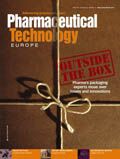Meeting New Packaging and Coding Requirements
More challenges face the pharma packaging industry today than ever before, according to Domino Printing Sciences' global life sciences sector manager.
Editor's Note: This article is part of a special feature on packaging that was published in the May issue of PTE Digital.
How has pharma's demand for coding technologies altered recently?
More challenges face the pharma packaging industry today than ever before. According to some estimates, the market for counterfeit and illegal drugs is worth between $75 billion to $200 billion.1 Such drugs are thought to kill more than 100000 people every year — mainly in developing countries,2 but more and more cases are occurring in developed regions, necessitating the need for anti-counterfeit technologies on packaged products.
Craig Stobie

Additionally, the industry must deal with fiscal recovery and legislative compliance programmes that oblige manufacturers to invest in and modify their existing production and packaging lines. In particular, there are a number of regulatory drivers pushing the industry to incorporate machine-readable codes, such as 2D Data Matrix codes, onto their packaging. These codes can increase patient safety by enabling product authentication, which can prevent reimbursement fraud and help identify counterfeits.
Mass serialisation is a growing area of interest and a number of countries are changing their packaging requirements to meet new traceability initiatives. As well as increasing the use of 2D barcodes, these initiatives will involve greater use of serialised numbers and increased levels of human readable information. One example of such a legislation is France's CIP13 mandate, which came into effect on 1 January 2011. The legislation requires pharmaceutical packages to incorporate a 2D data matrix code comprising product code, batch number and expiry date, alongside human-readable information. Other countries also have proposals in place to adopt a similar code structure.
These pieces of packaging legislation will require pharma companies to add new print and verification capabilities to their existing packaging lines. According to our research, up to 80% of currently installed coding devices within the pharmaceutical and healthcare sector cannot meet the required high speed and quality levels.
How are new coding systems adapting to these demands?
Coding small packs with detailed information at high speed is a challenging application. High-resolution coding technologies such as thermal ink jet or scribing laser are generally best-suited to this duty. While neither technology is brand new, there is a continued emphasis on optimising the technology to deliver fast, high quality coding for optimum packaging line efficiency. Where thermal inkjet technology is concerned, matching the ink to the substrate to be coded is important to ensure a crisp, highcontrast code. With laser, higher-powered models address the need for speed. In both cases, it's important to take a holistic view of the installation, rather than looking at coding in isolation.
Innovations in product identification are also taking place off the packaging lines. New technologies exploit the ubiquity of smart- and camera-equipped mobile phones by enabling patients to routinely capture data matrix codes of various types, which can then be cross-referenced with an online database to provide instant authentication. This is also a good way to build customer relationships.
Which technologies are proving popular for pharma companies?
At our company, we find that the most popular coding systems in the pharma industry are thermal ink jet and laser systems. Thermal ink jet enables the printing of highquality 2D Data Matrix codes and other machine-readable formats at high speeds. Such systems also have minimal maintenance because changing the cartridge changes the whole printhead, without the need for an engineer. Scribing lasers also enable the printing of unique numbers and codes, but also eliminate the risk of ink contamination, which makes them very popular in pharma applications. These laser systems also offer clear marking and require less maintenance. Recently, a number of advances have also been made in this area. These advances includes the development of high-powered lasers for faster performance and more robust, compact systems, as well as technologies to allow for a greater linear marking area.
Existing technologies are already well-suited to meet the current needs of the pharma industry in terms of legislation and traceability requirements. However, the challenge is to optimise these technologies to ensure that packaging and production lines are as lean and efficient as possible.
References
1. All News Wire, "Fake Drug Rings on the Rise" (September 2010). www.allnewswire.com
2. The Economist, "Poison pills" (September 2010). www.economist.com

Drug Solutions Podcast: A Closer Look at mRNA in Oncology and Vaccines
April 30th 2024In this episode fo the Drug Solutions Podcast, etherna’s vice-president of Technology and Innovation, Stefaan De Koker, discusses the merits and challenges of using mRNA as the foundation for therapeutics in oncology as well as for vaccines.